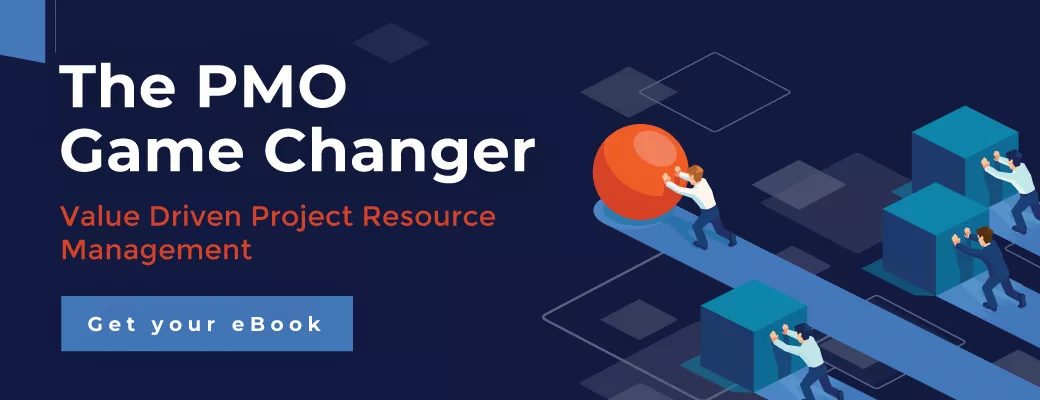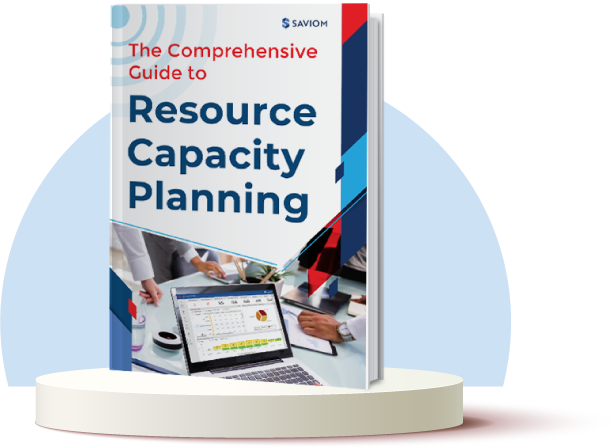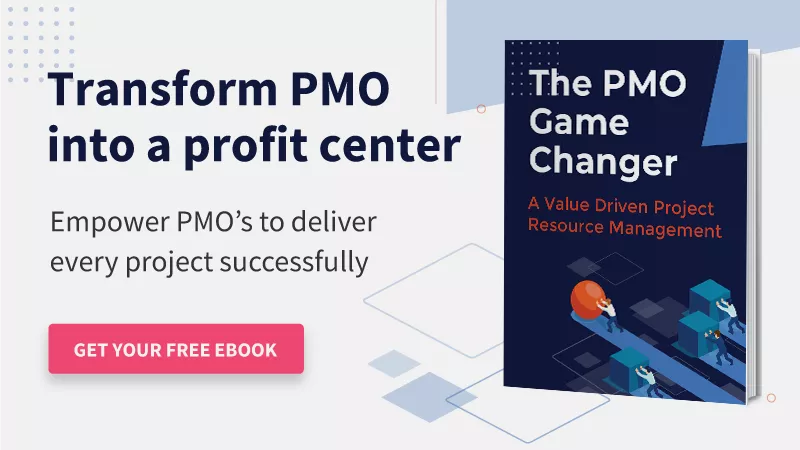What is a Value-Driven Project Resource Management?
Project resource management by PMO has changed significantly in the last 20 years. It is no more a mere spreadsheet for allocating resources to the projects and plug the holes. It has evolved into a highly value-driven resource management solution.
A value-driven resource management is designed to help a business reduce project resource cost, increase billable/strategic utilization, beat market volatility and more. It can potentially become a key component of business profitability and sustainability.
This article would help you understand how a value-driven resource management can become a major game-changer for the PMO and become a profit centre for the business.
How Value-Driven Resource Management can be a Game Changer for the PMO?
Traditionally a PMO is seen as an administrative group setting up the project management standards and generating management reports. But in the last few years, a PMO has started evolving into a value centre. In this journey, modern resource management has become a key player. It can potentially deliver these values to the business.
- Reduce Overall Project Resource Cost by 10-30%
- Increase Billable and Strategic Utilization by 10-20%
- Futureproof Your Workforce Against Market Volatility
- Leverage the Skills Across Matrix Org. Boundaries
- Improve Employee Productivity
- Reduce Resource Acquisition Cost
These benefits might sound unreal. But they are definitely achievable by a modern resource management solution.
Reduce Overall Project Resource Cost by 10-30 %
These are the capabilities of a value-driven resource management solution, which can help a business reduce overall project resource cost by 10-30%.
Minimize under/over skilled resources on projects: Both over and under-skilled resources increase the cost of the project. A modern resource management solution can help in identifying and allocating the right person with the right level of skill and experience.
Utilize cost-efficient global and local resources: An enterprise-level resource management solution can help you in allocating the right mix of local and global resources to the project. It can reduce resource cost significantly.
Minimize last-minute hiring cost and compromises: With proper resource capacity planning, one can forecast the future resource requirements and be proactive in acquiring the right resources at the right cost ahead of time.
Minimize hiring/firing wastage: Resource forecasting can help in identifying resource shortage ahead of time so that the internal staffs can be retrained or hire consultant or freelancer resources for short durations. It reduces unnecessary wastage due to hiring and firing.
Minimize Project Onboarding and Offboarding Time: An efficient and accurate resource planning and forecasting can help a PMO minimize onboarding and offboarding time.
Read More: Reduce Resourcing Cost by 10-30% with Modern Resource Management Solution
Increase Billable and Strategic Utilization by 10-20%
Maximizing billable utilization of resources in a professional service business is the key to profitability and sustainability. Similarly, maximizing strategic utilization of the resources is key to achieve the strategic goal of the business.
Improving billable and strategic resource utilization requires deep foresight into the overall utilization of resources. It is challenging work, especially in a matrix organization with a continually changing resource demand. But a modern resource management solution can help you get a real-time foresight into future resource utilization. So that corrective actions can be taken ahead of time.
Futureproof Your Workforce Against Market Volatility
Market volatility in the last few years is continuously impacting the viability of every business. A smart resource capacity planning process can help you forecast a shortage or excesses of the resources and help you take proactive action.
Read More: What is Resource Capacity Planning? An Ultimate Guide for Every Project Manager
Bridge Resource Shortage Proactively
- Retraining existing employees
- Smoothening the project workload
- Hiring contingent resources ahead of time
Forward Plan and Utilize Excess Resources
- Bringing forward future projects
- Selling resource time aggressively
- Restructuring capacity in different areas
Leverage the Skills of Resources Across Matrix Org. Structure
In a matrix organization structure, it may be challenging to acquire a particular skilled resource in one location compared to others. With an enterprise resource management solution, a PMO can easily identify the person with the right competencies and utilize him/her in any part of the world. At the same time, a high skilled person also can be used to provide training and to a person on the bench.
Improve Employee Communication and Productivity
A value-driven resource management solution provides end-to-end work management along with collaboration to ensure that employees are working productively onsite and remotely. This solution can help a business:
- Track status and time spent on both planned and unplanned work
- Enable workflows to streamline project and resource management processes
- Enable seamless team collaboration to improve communication
Read More: 11 Ways to Improve Cross-Departmental Collaboration
Best Practices of Enterprise Resource Management Software
Resource management has evolved a lot during the last few years. Matured businesses have adopted well-developed and defined practices to get the best value out of their enterprise resources. Following are the best practices adopted across the industries.
Enterprise Resource Scheduling: Replace Silos with a Single Plan
Replace silos of spreadsheets or home-grown tools with a single real-time resource plan across the whole enterprise. Establish a single source of truth about resource allocations to the projects or non-project work such as BAU, Support, admin, operation, and more.
Workforce Optimization: Allocate Right Resource to the Right Project
Identify cost-effective competent resources with a click of a button across a matrixed organization structure so that the right resource can be allocated to the right project at the right time at the right cost.
Resource Utilization Forecasting: Maximize Billable and Strategic Utilisation
Get foresight into the future utilization of resources with real-time forecasting and analyze how effective they are. Accordingly, move employees from non-billable work to billable or strategic work. Improvement in effective utilization has a direct impact on the profitability of the business,
Read More: What is Resource Forecasting? An Ultimate Guide for Project Managers
Resource Capacity Planning: Minimize Shortfall or Excesses of Resources
Forecast shortfall and excesses of resources ahead of time by identifying the gap between resource capacity against demand. Accordingly build strategies to bridge this capacity gap by juggling around project timelines, retrain current employees or hire a contingent workforce.
Pipeline Project Management: Forecast Proactively for Future Projects
Forward plan resource requirements for future or pipeline projects. Start identifying and acquiring cost-efficient competent resources ahead of time. Avoid last-minute hiring and reduces the overall cost of the project.
Read More: 4 steps to perfect your Project Pipeline Management strategy
End-to-End Project Forecasting: Gain Real-Time Foresight into the Future
Resource supply and demand scenario change fast in almost every business. So, it is critical to have a real-time forecasting capability and get an early warning at every stage of the project life cycle. It helps in early decision making and take corrective actions proactively.
Team Collaboration: Streamline Communication and Reduce Chaos
Enable team collaboration with the modern-day solution. It can seamlessly bring remotely distributed team on a single platform. Minimize waiting period and complete task efficiently in a lesser period.
Resource Modelling: Simulate and Improve Decision Making
Use what-if analysis to get the best possible project resourcing outcome within the existing constraints. It helps you in moving around the project’s timelines based on priorities and put low-priority projects on hold.
Business Intelligence: Real-Time Multi-Dimensional Data Analysis
Get real-time business intelligence for dynamically changing business scenarios. Do multi-dimensional analysis as per the specific requirements of stakeholders and get a granular view of data with configurable filters.
Read More: Top Ten Resource Management Best Practices for Business Efficiency
How to Select a Resource Management Software
Even though the fundamental principles of resource management may be the same, but every business has a set of unique requirements for the software. It depends upon the industry and type of business. So, selecting the right resource management tool is a complex process that requires a number of careful considerations.
Following are some of these criteria that can be used to evaluate the right resource management software: –
User Interface and User Experience
An essential part of software selection is that the end-user of the product likes user interface and can navigate through the system effortlessly without going thru too many clicks.
Manages Complexity of Matrix Organization Structure
Matrixed organization structure has multiple reporting lines making resource identification, allocation, utilization very hard. So, the software should be capable of overcoming challenges of such complexities and manage resource efficiently and take care of the needs of different stakeholders.
Needs to be Configurable, Expandability and Scalable
The software should be highly configurable to meet the specific needs of the business without compromise so that the business would have a competitive edge against the rivals. The software should also be expandable and scalable as per the growing needs of the business.
Capability to Reduce Resource Cost
Resource management software should help your business to do multi-dimensional forecasting so that the business can get real-time business intelligence to improve business performance, profitability, and productivity.
Provides Real-Time Business Intelligence
Resource demand changes every minute in real life. So, it is crucial to have real-time business intelligence, i.e. reports, analytics, and dashboards. It enables the management taking decisions based on the latest information
Integrates with Other Legacy Systems
Most businesses have already invested in enterprise-level systems. They hold quite a bit of data required by a resource management solution, i.e., resource profile, competencies, project detail, etc. So, the resource management system must integrate seamlessly with existing applications.
Provides High Return on Investment
Select a tool that provides a high return on investment in a short time. It should be possible to have a small phase of implementation without lots of investment so that the risk of investment and change management can be minimized.
Read More: How to Select the Best Resource Management Solution for your Business
The SAVIOM Solution
SAVIOM provides state of the art tool for supporting value-driven PMO. It has more than 20 years of experience working with high valued global companies around the world. SAVIOM also provides tools for enterprise resource management, professional service automation, and workforce planning software. So, SAVIOM can help your business to establish an efficient system geared towards your specific business challenges.












